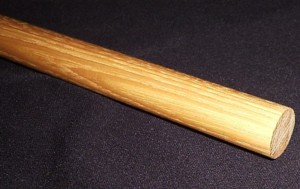A Primer on Hanbojutsu
Visit the Jinenkan Webstore to purchase Hanbo technique downloads.
Hickory Hanbo, hand-made and top quality, are available from the Jinenkan Seigi Dojo.
The hanbo is a fundamental weapon and training tool of the Jinenkan. It is a simple, straight, three-foot long hardwood stick, but it's method of use varies greatly from those of other staff weapons. Learning to use it in stickfighting requires using the whole body in a relaxed and coordinated manner. Though the weapon is very plain, the art of hanbojutsu contains many remarkable lessons.
Hanbo means simply "half-staff (stick)". An alternate name is San-Jyaku-Bo, meaning a stick three shaku long, where one shaku equals roughly one foot. This alternate name originates from when a Rokushaku (“six foot”) Bo is cut in half by a sword.
 This hanbo, hand-made from hickory, is 7/8" in diameter and 36" long.
The hanbojutsu, or “half-staff technique”, of the Jinenkan originates in the Kukishin Ryu. This ancient martial school also teaches Rokushaku Bojutsu and Jojutsu; however, hanbojutsu is very different from these other stickfighting arts. The opponent is generally assumed to be wielding a sword; therefore, the longer sticks must be used in an aggressive manner, keeping the swordsman at long range and preventing him from closing. By contrast, the hanbo is too short to keep a swordsman back. Learning these methods requires entering in close to an armed opponent. Therefore, the hanbo is used to get inside the sword to close range, and then strike, pin the attacker's arms, or otherwise subdue him. The kata ("forms") are reactive- allowing the opponent to move first, and then moving to exploit an opening. None of the kamae ("stances") resemble pure fighting
stances, and do not look threatening. The varied methods of using the hanbo include "scissoring, thrusting, striking, placing and scraping, and placing and pushing." The Kukishin Ryu does not contain as many hanbo forms Rokushaku Bojutsu, but learning the timing and way to enter properly can be quite difficult.
Unlike Bojutsu, Jojutsu, Filipino Martial Arts, or other such styles, the hanbo is not wielded in an aggressive way. Often, the exponent holds it like a cane, or in another unobtrusive way. Therefore, developing acute timing and footwork are essential. Strikes with the hanbo are often delivered in a reverse manner, with the stick projecting from the little-finger side of the hand, not up from the thumb. Power is not generated by the arm and shoulder muscles, but by moving the whole body as one unit. This allows the hanbo to strike suddenly from surprising positions and with little telegraphing. It requires whole-body coordination involving the legs, hips, arms, and wrists. The exponent learns to grip the hanbo with either or both hands, and must master grasping it firmly and lightly, sliding it between the hands, releasing it with either hand, and changing grip.
Kukishin Ryu Hanbojutsu (or Sanjyaku-bojutsu) uses a familiar system of organizating techniques. Students first learn the Kihon Happo, or set of "Eight Basic Techniques". This teaches students methods of swinging the hanbo, striking with it, and catching and locking an attacker. The Kihon Happo is the only place where the attacker is unarmed. The following level, the Shoden no Kata or "forms of the first teachings", specifies the attacker is armed with a Shoto ("short sword"): there are nine techniques. In the remaining levels, the Chuden no Kata ("middle teachings") and Okuden no Kata ("secret teachings"), the opponent is armed with a Daito, or "long sword". There are, respectively, four and three kata in each level.
In many ways, the hanbo is the counterpart of the bo; whereas the bo requires dynamic movement and aggressive application, the hanbo seems "quieter" and more unassuming. Both weapons require movement involving the whole body, with the hanbo emphasizing waiting for the right moment, and then moving decisively. This quality and kind of movement are essential to making progress in martial arts. Because wielding it requires whole body coordination, it instantly reveals bad habits to an examiner's eye. Practicing rigorously with the hanbo improves overall movement, and the ability to generate power seemingly without warning. Command of timing and distance also improve with steady practice.
Mastering this weapon is difficult, but also essential to understanding the fundamental principles of our martial arts.
The quotation above and the source material for this essay were drawn from Manaka Sensei's article "Kukishin-Ryu Hanbojutsu (Sanjaku Bojutsu)", owned under copyright (2000) by the Jissen Kobudo Jinenkan.
In addition, slight variations in the anglicized spelling of Japanese names were used, to reflect that different spellings may be used.
This article is a revised version of one published on the Jinenkan Ottawa Dojo Web site in 2003-2004. |